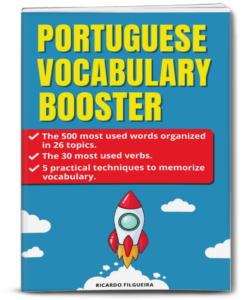You’re going to learn today:
- The 500 most used words organized in 26 topics (adverbs, nouns, prepositions, adjectives…);
- The 30 most used verbs;
- 5 practical techniques to memorize vocabulary.
You will know exactly what you need to learn to have a solid vocabulary foundation for you to express yourself in everyday situations!
Why is vocabulary so important?
It’s obvious: languages are made of words, the more words you know, the more things you can talk about.
It’s no use just having good pronunciation, good listening and good grammar knowledge.
If your vocabulary is poor, your communication skill is limited, period!
Ok, but what are the effective ways of learning vocabulary?
Before I show you the 5 strategies to memorize vocabulary in a smarter and efficient way, you need to understand how our memory works to learn better.
1 – How our memory works
Memory is ‘the faculty by which the mind stores and remembers information’.
But how does it actually work? Well, there are three main processes involved: encoding, storage, and retrieval.
1.1 – Encoding
The process of memory begins with encoding: acquiring or learning new information.
When information comes into our memory system (from sensory input), it needs to be changed into a form that the system can cope with, so that it can be stored.
There are three main ways in which information can be encoded:
1. Visual (picture)
2. Acoustic (sound)
3. Semantic (meaning)
For example, how do you remember a telephone number you have looked up in the phone book? If you can see it then you are using visual coding, but if you are repeating it to yourself you are using acoustic coding (by sound).
1.2 – Storage
After the information has been encoded, it goes to storage so that we can recall, or use it later.
There are two types of storage. When you first encounter something new, this information goes to your short-term memory. From here, it is either forgotten or, if needed and stored correctly, goes to your long-term memory.
Your short-term memory is at work when you do something like read a list of words and then immediately repeat them. It helps you to quickly obtain the information you need at the moment, while you are performing a task, but it’s highly likely you will forget this information afterwards.
Our long-term memory has a much longer time span (from a few minutes to a lifetime) with practically unlimited capacity. For information to be transferred from your short-term memory into your long term memory, you need to repeat it or interact with it at least a few times.
1.3 – Retrieval
The final step of the process is retrieval, it refers to getting information out of storage. Basically, there are two different types of retrieval: recall and recognition.
Recognition
This type of memory retrieval involves identifying information after experiencing it again. For example, taking a multiple-choice quiz requires that you recognize the correct answer out of a group of available answers.
It occurs when you recognize something, you have some kind of clue that helps you retrieve information.
Recall
This type of memory retrieval involves being able to access the information without being cued. Answering a question on a fill-in-the-blank test is a good example of recall.
You can often quite easily recognize new vocabulary when you are reading a text, but recalling it without any cues when you need to produce it in a conversation can be much harder.
So, keep this in mind: just because you can recognize a word it doesn’t necessarily mean you can recall it to the point of using it when speaking or writing.
2 – The Forgetting Curve
Another important concept to understand why we forget things is The Forgetting Curve, also known as the ‘Ebbinghaus Forgetting Curve’.
Created by the German psychologist Hermann Ebbinghaus, the forgetting curve hypothesizes the decline of memory retention in time. This curve shows how information is lost over time when there is no attempt to retain it.
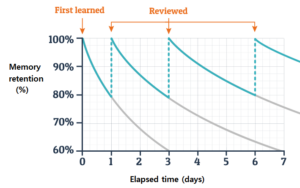
He found out that the forgetting curve is exponential in nature. After you have just learned something, memory retention is 100%. However, it drops rapidly to 40% within just a few days. After that, the decline of memory retention slows down again.
Ebbinghaus also found out that if you repeat or practice something a lot, the information is stored more strongly and the forgetting curve becomes much more shallow.
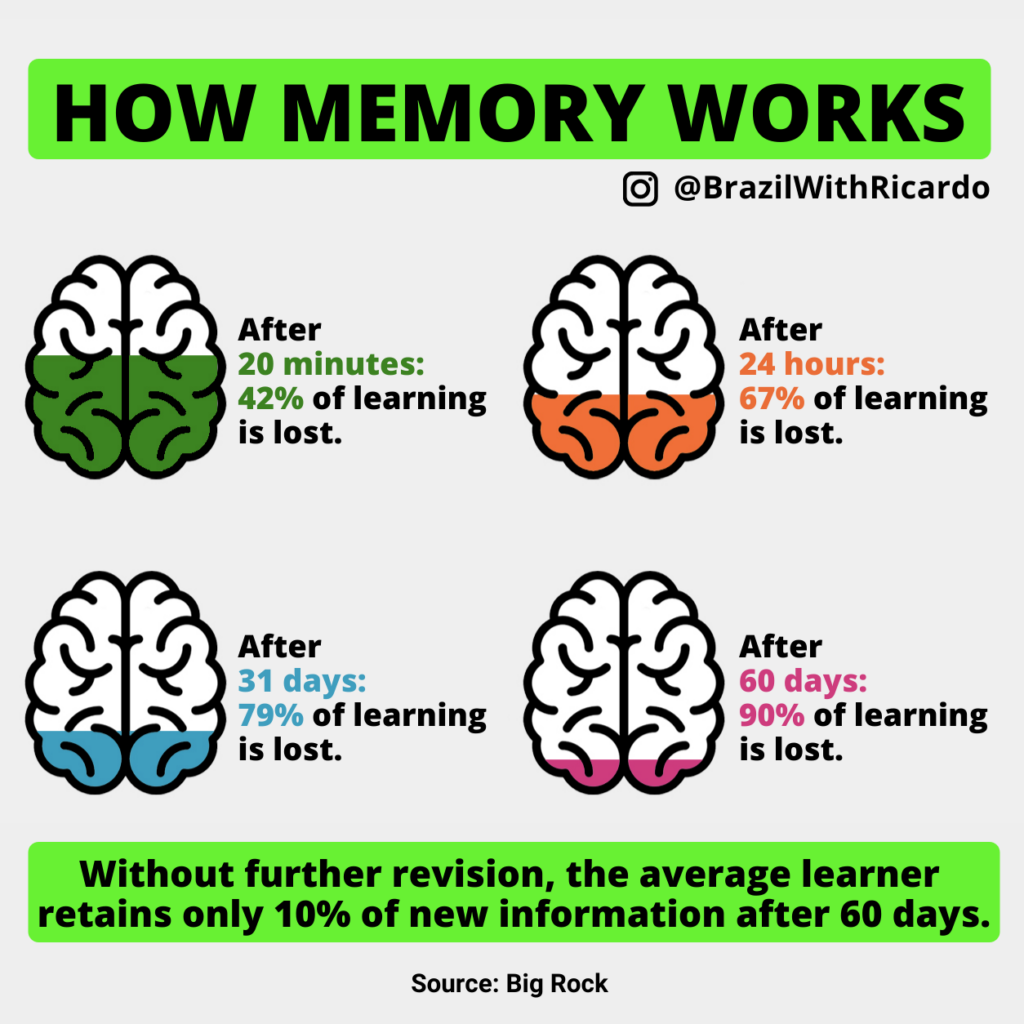
When exposed to the same content repeatedly, it takes less time to pull the information from your long-term memory.
And here is where most students who want to learn a language fail: they don’t have the patience to review, they don’t give the brain time to retain what they’ve learned.
And I understand that. It’s really boring having to review the same content over and over again.
In fact, for you to have a better retention of what you study, it is ideal that this review is done in different contexts and formats.
Let’s say you want to learn greetings and introductions (boa tarde, olá, meu nome é, como vai você…). These terms are easier to memorize if you see and practice them in different formats, such as: watching dialogues, listening to short stories, taking tests, writing… And, of course, carrying out a conversation practice with these terms..
3 – Techniques to memorize vocabulary
Now that you know how our memory works, it’s time to learn practical techniques to memorize vocabulary.
3.1 – Learn words in context
A good idea to learn more words faster is to put them in context: Instead of writing lists of random words, try to put them in sentences. That way, you know how the word is used in real life.
Without any context, memorising lists of vocabulary is extremely counterproductive. You won’t remember the words for very long if you don’t use them and they are not meaningful.
You can learn many words, maybe 10 to 15 new words a day. But if you don’t use them, you will forget them in a short period of time.
As children, most of the words we learn are learned in context – not by memorizing vocabulary lists. Memorizing lists of vocabulary words is ineffective and unnatural.
3.2 – Use Dual Coding
We are visual creatures, about 80-90% of the information we absorb is visual. We recall information supported by images much more effectively.
The best way to use this in favor of language learning is to adopt Dual Coding. This theory of cognition uses the idea that the formation of mental images aids in learning, combining words and visuals such as pictures, diagrams, graphics and so on.
The idea is to provide two different representations of the information, both visual and verbal, to help students understand the information better. Adding visuals to a verbal description can make the presented ideas more concrete, and provides two ways of understanding the presented ideas
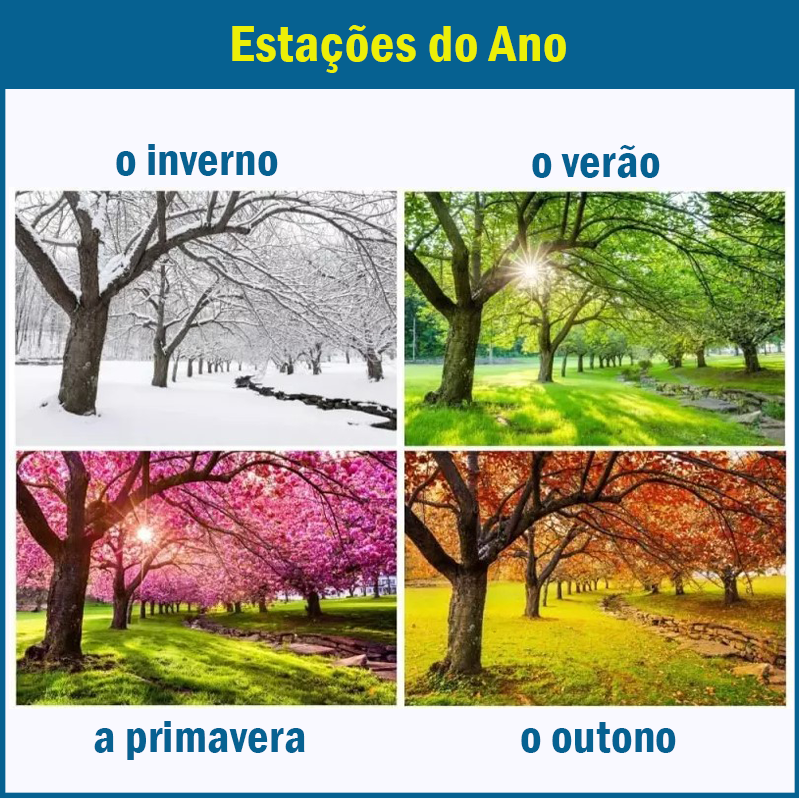
Dual coding is about more than just adding pictures. Instead, the visuals should be meaningful, and students should have enough time to integrate the two representations, otherwise, cognitive overload could occur.
There is scientific evidence backing dual coding, showing that when we combine representations it is easier for students to learn and understand the material.

When Dual Coding is well applied, concepts are learned intuitively. In the example above (Estações do Ano), no translation was needed, but even so, you understood everything in that picture.
3.3 – Prioritize vocabulary
The biggest potential risk of actively trying to learn lots of vocabulary is that you end up wasting time learning words that realistically you will never use.
This means that you will not see the results from all the time you’re putting into learning, which will lead to your progress slowing, and your motivation dropping.
As a solution to this, simply don’t learn those useless words at all! Instead, always learn the words that directly relate to your situation, and prioritise the ones that you know you will have to use.
Many of my students want to learn Portuguese to have a better experience during their trip to Brazil.
If this is your case, then you should focus on learning words and expressions that are useful in travel context, for example: transport, shopping, ordering food, hanging out etc.
The way to acquire this vocabulary is by learning language chunks.
3.4 – Learn language chuncks
According to Michael Lewis (The Lexical Approach), the focus of learning a new language should be on learning vocabulary.
He believes that the ‘largest bulk involved in learning a new language is the vocabulary, and more specifically, vocabulary chunks’.
The term ‘chunk’ refers to a group of connected words that are treated as single concepts.
Also known as lexical phrases and collocations, language chunks are groups of words that naturally go together – they are fixed expressions and they can’t usually be changed.
So instead of learning them word by word, we can think of them as one complete piece of language.
Chunks also play a crucial role in early second language acquisition. Learners can engage in basic conversations using chunks as unanalysed wholes:
Bom dia! – Good morning!
Como vai você? – How are you?
Desculpe. – I’m sorry.
Obrigado. – Thank you.
De nada. – You’re welcome.
These are set phrases that are used to express a certain function, such as: greeting and apologizing.
The grammar of these phrases is not so important, so you can easily learn them even if you don’t understand how they are made grammatically.
There are also chunks that can be used as templates to generate new utterances:
- Eu estou com vontade de dançar. (I feel like dancing.)
- Eu estou com vontade de dormir. (I feel like sleeping.)
- Eu estou com vontade de comer chocolate! (I feel like eating chocolate!)
Every skill is composed of chunks that aggregate to form the greater whole.
For example, if you want to learn how to swing a golf club, you need to learn several different things: how to grip the club, how to position your feet, the proper stance, how to bend your elbow in the backswing, how to follow through, where to focus your eyes during the swing, how to retrieve your golf ball from the woods, etc.
It would be impossible to learn everything at once since our working memory can only hold about seven items of information at a time.
So, decompressing the skill into bite-sized chunks and mastering them one at a time until the act becomes unconscious is an effective way of learning.
A native speaker’s output consists of an infinite number of “creative” utterances. Prefabricated items represent a significant portion of a native speaker’s spoken and written output. Native speakers have a vast stock of these lexical prefabricated items or chunks and are vital for fluent production.
That’s why linguists and polyglots agree on one thing: dwelling on grammar rules hinders the communication process, mainly if you are a beginner. It brings a lot of frustration, mainly if your purpose is to speak.
Grammar is useful for making a language sound correct, but not for actually getting started. Sometimes, it helps to clarify some points, but you shouldn’t make it a priority.
You should worry about learning grammar only after you have already gained confidence with the essential structures of the language.
3.5 – Use apps to memorize vocabulary
There are many apps that help us memorize vocabulary. But, to tell you the truth, the two apps that are really worth investing your time are Anki and Quizlet.
Anki
Anki is the best Spaced-Repetition System. Spaced-repetition works by presenting you with information right before you forget it to make sure that it stays fresh in your mind. You don’t mindlessly repeat information over and over again; you repeat it across increasing intervals of time.
For example, say, you’ve learned some Portuguese greetings before your trip to Brazil. You repeat them a few minutes later, then a few hours, then a day, then a few days, then a week…
Spaced-repetition is designed to ‘fight’ the forgetting curve and trains your brain so you can recall information at longer intervals.

- It uses spaced repetition.
- For android and desktop users it’s completely free.
- Easy and completely free to use offline.
- There are loads of add-ons available so that you can customise your learning experience.

- The app/desktop program has a very clunky and old fashioned feel to it and isn’t very intuitive.
- Only one standard study mode which can get repetitive and boring.
- For iOS users you have to pay $25 for lifetime use.
- Syncing between desktop version and mobile version isn’t automatic.
Quizlet
Quizlet is a free website and app providing learning tools for students, including flashcards (its best feature to memorize vocabulary), study and game modes.
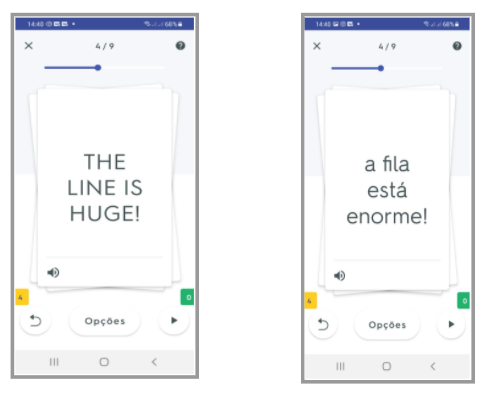
3.5 – Use apps to memorize vocabulary
You start by creating your own study sets with terms and definitions. You can copy and paste from another source, or use Quizlet’s built-in auto-define feature to speed up the creating process.

- Very easy to use and it’s super intuitive.
- It has a number of different study modes so that you don’t get bored of just looking at flash cards.
- Test feature is really useful for tracking your progress.
- The design is clean, simple and easy to navigate.

- It no longer uses spaced repetition.
- To get all the features you need to pay to upgrade to Quizlet Plus.
When looking at whether you should choose Anki vs Quizlet you really need to look at two things: your preferred learning style and your study goals.
If your aim is to learn vocabulary as effectively as possible and you are happy with a straight forward, simple flashcard app then Anki is definitely the one for you.
I personally prefer Quizlet because it is more of an interactive learning experience with different study methods and also some games.
Top tip
Regardless of whether you use Anki or Quizlet, you need to take 3 things into consideration:
- Avoid information overload, create a maximum of 15 cards for each deck;
- Instead of writing isolated words, make short sentences, focusing on a structure or topic. Remember, always put words into context;
- Make sure these phrases are correct and they are actually used in the context you use them (ask a teacher, a native).
Now, I want to show you a practical example of how to create a deck. Imagine that you want to learn the verb IR (to go) in the simple present tense. See my suggestion:
Card 1: Eu vou para a praia -> I’m going to the beach.
Card 2: Você vai para o supermercado -> You’re going to the supermarket.
Card 3: Ele/ela vai para o museu -> He/she is going to the museum.
Card 4: Nós vamos para o teatro -> We are going to the theater.
Card 5: Vocês vão para a loja -> You’re going to the store.
Card 6: Eles vão para a biblioteca -> They are going to the library.
It’s the perfect combination! You learn personal pronouns, articles, the simple present structure and locations at once.
And speaking of verbs, I strongly recommend you to always take them into consideration when you create your decks.
Remember that verbs in Portuguese are conjugated by person and number, meaning that you’ll have to memorize 4 different endings for each verb that you learn.
If that’s not enough, the conjugations can be different depending on whether the verb ends in -ar, -er, or -ir. And even further, verb tenses (e.g., past, present, future) are all conjugated differently.
It’s no wonder that memorizing conjugations is one of the greatest stumbling blocks for Portuguese learners!


